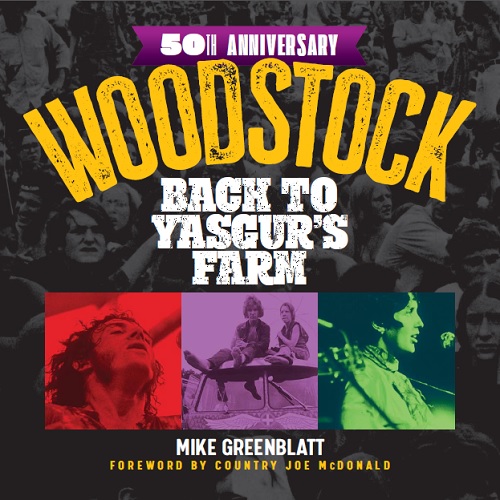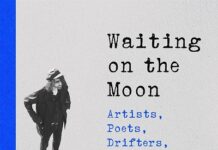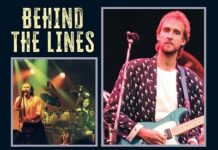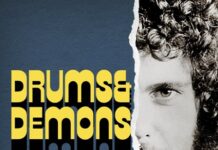Woodstock’s 50th anniversary is getting a major push from various corners. There’s the event’s promoter, Michael Lang, hoping to mark the anniversary with the Woodstock 50 festival. At press time, there’s a good possibility it won’t happen. Meanwhile in Bethel, there are plans for a series of concerts and events at the amphitheater and museum that overlook Max Yasgur’s farm, where 50 years earlier, a sea of humanity peacefully gathered. And you can bet there’s a load of CD, DVD, and book releases already on the market. Everyone has a story. Mike Greenblatt, who attended Woodstock, shares his in a remarkable 224-page book called Woodstock 50th Anniversary: Back To Yasgur’s Farm.
Packed with over 300 photos and a Foreword by Country Joe McDonald, whose memorable “The Fish Cheer/I-Feel-Like-I’m-Fixin’-To-Die Rag” moment remains one of the festival’s highlights, Woodstock 50th Anniversary: Back To Yasgur’s Farm warmly mixes factoids, statistics and insight with one young man’s personal odyssey to what would become one of the greatest “happenings” in modern history. Despite taking the “brown acid,” Greenblatt recalls the events of the day with acute lucidity and accuracy. While it would be easy to name-check the musicians who played, the book zeroes in on those behind the scenes, the ones who put their lives aside for the previous weeks before, during and after Woodstock to make it a reality.
The logistics of producing a show of this magnitude is as fascinating as the show itself. Especially when you consider that something like this had never been done before. From securing the site, to building the stage, to getting people and equipment in out and out, to staying on schedule (not quite), to keeping everyone fed, hydrated, healthy, sane, and alive — people like Chris Langhart, John Morris, Bill Hanley, Chip Monck, Mel Lawrence, Stanley Goldstein, Wavy Gravy, John Chester, and of course, Michael Lang were the instigators, the stewards, essentially adult supervision for 32 acts and a half-million free, unpredictable souls.
Technical director and designer Langhart was responsible for the backstage area, the medical tent, the free kitchen and the VIP area. Morris booked most of the bands, and unwittingly became the emcee at Woodstock who announced it was a free concert. Hanley, known as “the father of festival sound” built the sound system, which had to reach the upper reaches of the 600-acre farm. Each was met, as Greenblatt notes, with numerous impactful challenges they handled with diligence, patience, and grace under extreme pressure. By citing their contributions, the credibility of this book transcends the sensationalistic hype that could have been so easily employ. Greenblatt, as a veteran music journalist and publicist, surely recognizes the pitfalls associated with that route.
And through it, the author and his buddy Neil, who steadfastly stayed straight the whole time, endure the hunger, the parking (miles way and the car miraculously still there afterwards), discomfort, and inconvenience for the music and spirit of community. “I thought for a moment it was a dream,” Greenblatt writes. “I never saw so many people in one place at one time and we were at the head of the whole shebang, right by the stage.”
One of the more disheartening tales from Woodstock is what happened to Max Yasgur after the festival. Despite the locals praising the attendees for not destroying the countryside and being civil, they weren’t too happy with Yasgur. After the festival, many reportedly boycotted his dairy farm and didn’t buy his milk. According to Greenblatt, “his own neighbors turned their backs on him and the general store wouldn’t accept his goods.” He ended up selling the farm two years after Woodstock, moved to Florida, and suffered a fatal heart attack in 1973 at the age of 53.
The book is filled with random tidbits and anecdotes to fatten the tale — Iron Butterfly’s unreasonable demands lead to their elimination from the bill; Tim Hardin’s fear of being asked to open the show (he was a heroin addict in bad shape); the National Guard nearly showing up to clear everyone out; the fear of possible electrocution when the rain started to fall; Pete Townshend of the Who commits the only violent act at the festival when he hits Abbie Hoffman over the head with his guitar; and bands that didn’t fare so well from Woodstock include Sweetwater, Bert Sommer, Quill, and the Incredible String Band.
There are also a few sidebars to Greenblatt’s adventures, including setlists, personnel, performance fees and a few words about the Woodstock experience of each act. We hear about the bands that didn’t play like the Beatles, Bob Dylan, the Doors, Led Zeppelin, Jethro Tull, and the Jeff Beck Group. There’s even a couple of pages about the Woodstock couple, Nick and Bobbi Ercoline, who became immortalized when the Woodstock soundtrack album came out. The couple, who are still together, had only been dating for a short time when they went to Woodstock and were caught in a warm embrace by photographer Burk Uzzie. The photo was featured in magazines and used as the cover of the soundtrack album.
One of the biggest things to come out of Woodstock, along with the soundtrack, was the movie. Directed by Michael Wadleigh, Woodstock won an Oscar for Best Documentary in 1970 and escalated the careers of Richie Havens, Country Joe McDonald, Santana, Ten Years After, and most any other performer who made the cut. As we learn, several did not appear in the movie for various reasons. For some of the lesser known acts, a spot in the Woodstock movie would have been a definite game-changer. For Creedence Clearwater Revival and the Grateful Dead, two bands whose appearances at Woodstock were left out of the movie, their trajectories into fame would have happened regardless.
For Mike Greenblatt, attending Woodstock definitely played a role in his career aspirations. Fifty years later, even the “brown acid” couldn’t cloud his memory or the enthusiasm he puts into this book. Anyone feeling nostalgic for three days of peace and love owe themselves a fun and fact-filled read like Woodstock 50th Anniversary: Back To Yasgur’s Farm.




















